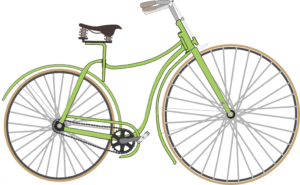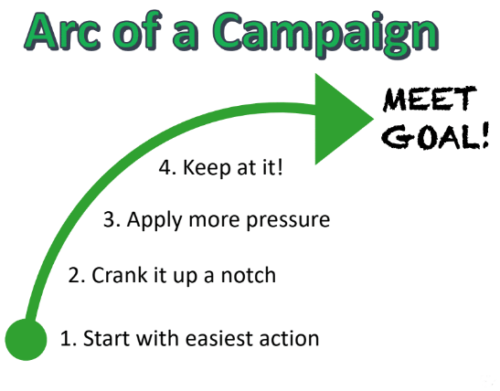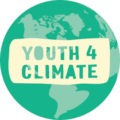5. Tactics Best For You
Design Your Campaign
CAMPAIGN:
- A series of actions designed to achieve a goal.
- Campaigns use a variety of ”tactics".
TACTIC:
- A strategy or action thoughtfully planned to achieve a specific outcome.
- Experiment: Try different tactics— see what works. Review what worked (or didn’t) last time. Try something new. Be creative!
- Typically, different tactics are used within a single campaign to keep the pressure on the “target.”
TARGET:
- People with the power to take action to achieve your goal.
ASK/DEMAND:
- The positive action you want taken to achieve your specific goal.
ORGANIZING:
- Process of taking collective action to achieve clear, concrete goal with feedback loops to evaluat.

Make sure your team is up for the action!
| For Each Goal: | Example: |
| 1. DEFINE THE CHANGE YOU WANT TO SEE | – Go fossil free |
|
2. IDENTIFY YOUR TARGET: Target: People with power to take action. Or, who are the people who can influence the target? |
– Elected officials – School administrators – Parents, teachers, student sents |
|
3. HOW CAN YOU INFLUENCE YOUR TARGET TO TAKE ACTION? Ask them to take a specific action or give them information. |
– Declare Climate Emergency – Divest from fossil fuels – Support Green New Deal |
|
4. WHAT’S THE MOST EFFECTIVE WAY TO APPLY PRESSURE TO THE TARGET? Campaigns use a variety of tactics. Get creative—see how you can pressure your target to change. |
See Tactics: – Advocacy– Direct Action – Education & Outreach |
|
5.GAIN SUPPORT Get people on board with your cause. |
– Share with friends – Make a petition§Post flyers – Write an article – Attract people to a larger event |
Learn About Tactics
Start with these three types of tactics:
- Advocacy
- Direct Action
- Education&Outreach
Be sure all of your actions and events are safe and peaceful.
1. Advocacy
When you publicly support or make are commendation for something that relates to your goal. Advocacy often involves giving your target information and asking them to take a specification.
Examples: Go to PTA and ask them to sign a letter, meet one-on-one with member of schoolboard, meet with an elected official and ask them to take action.
2. Direct Action
Call attention to a specific issue: Put yourself in front of your target so you can’t be ignored. Do something provocative that will get people’s attention(safe and peaceful).
“Nonviolent direct action seeks to … dramatize the issue so that it can no longer be ignored…”
Dr. Martin Luther King, JR
Tell the story in a dramatic way — either to the general public, the media, or the people you are targeting.
Examples: Stage a “Die-In,” organize a rally, hold a climate strike or walk-out.
3.Education & Outreach
Often used in conjunction with Advocacy to win people over to your side and get them on board with your cause.
Explain your position, use simple facts, and make sure people understand the basic issue.
By expanding the number of people involved with your cause,it becomes much clearer to the decision-makers that they need to pay attention.
Main Goal:
a) Attract people to your events.
b) Inform them about the Climate Crisis and what they can do to about it.
c) Get them to take action.
See STEP #7: How to Communicate about Climate Change
Examples: Hold a meeting, publish an article, organize a fair on the topic, do the Climate Ribbon Project.

Adopt another club or organization’s action as your own: Put their event on your roadmap. Join forces for powerful results!
Direct Action
MARTIN LUTHER KING, JR:
“Martin LutherKing Jr., sitting in a jail cell in 1963, was right: Direct action can help to bring reluctant parties to the negotiation table. Today’s climate leaders like GretaThunberg, Alexandria Villasenor, Alexandria Ocasio-Cortez, and others are walking in Dr. King’s shoes… Pushing the conversation from a backburner issue to a crisis point that has opened the door to negotiation. Once atthetable, we will quickly realize that we have all the tools needed to achieve deep decarbonization.”
The Aspen Institute


Activity #5A:
Experiment with Tactics
1. Read about different tactics and tell us why you’re excited to use a specific one.
Look at other tactics, get new ideas—which look fun to you?
2. Research your target.
Which tactics will be most effective to influence this person?
3. Create a Campaign.
Describe how you can use the following tactics to help you achieve your goal (be specific, with your target in mind):

4. Update your roadmap based on your tactics.
How do they fit in the best? Go back and make adjustments to your roadmap.
Choose the Best Fit
1. Align Your Tactics with Your Goal
There’s an art to choosing the right tactic.Try things out—you’ll get a better idea of what works as you go along.
2. Be Creative
Have fun, think out side the box. Use the Creative Collaborative method to think up new ideas.
3.Arc of a Campaign
Start with the easiest, least confrontational. If that doesn’t work, crank it up a notch. Still not working? Apply more pressure.
4.Persistence & Resilience
Youth have an advantage: when we start taking action in noticeable numbers, people tend to pay attention. Use your passion, grow support, and keep at it!
Greta Thunberg sat outside alone for several Fridays before others started joining her. Her persistence grew into amovement.


Activity #5B:
Which Tactics Fit Best?
Assess your club’s resources.
For each idea for a tactic, evaluate if you have enough:
- People
- Time
- Resources
- Excitement: Are club members willing to take it on and actually dothe work?

Meet: Chris Kracha Mission
Bay High School, San Diego, CA

HOT TIP:
“Opt for collective action when asked on how to address the climate crisis. Organizing allows you to collectively reach more people and spread an inherent culture of individual action alongside it.”
WHAT I’VE LEARNED:
“If you can’t convince an elected official, convince their constituents instead.”
Chris raised support for a park restoration campaign in SD city hall andhelped to organize a die-in at a Congressional office to support the Green New Deal.
Activities: Writing press materials, planning actions.
Inspirations: climate anxiety, opportunity for climate resilience, government inaction.
Highlight: Writing the resolutions passed by the San Diego Unified and Sweetwater Unified School Districts supporting student and teacher participation as part of the September 2019 climate strike.
Quick Guide #5
-
START WITH YOUR OBJECTIVE
What’s your goal? See Step #2. What does the group want to take on?
-
WHO IS YOUR TARGET?
Research who you’re trying to influence. What do they personally care about? Choose your tactics on what will most effectively influence them. Do some research, find out their motivation.
-
WHICH TACTICS WILL WORK TO ACHIEVE GOAL?
Use Creative Collaboration to find out what sounds fun to your team. Brainstorm several ideas. Fulfill your high-level goals.
-
WHICH TACTIC FITS?
Assess your club’s resources.
-
USE THE SMART CHART TOOL
Is your idea for an action SMART? Before you take it on, make sure it’s SMART.
-
DESIGN A CAMPAIGN
See if you can put together a plan to use several different tactics to achieve goal.
-
MAKE IT FUN!
All tactics should have an element of fun—keep people engaged for the long run.
-
EVALUATE OFTEN
What’s working? What needs to be changed?






